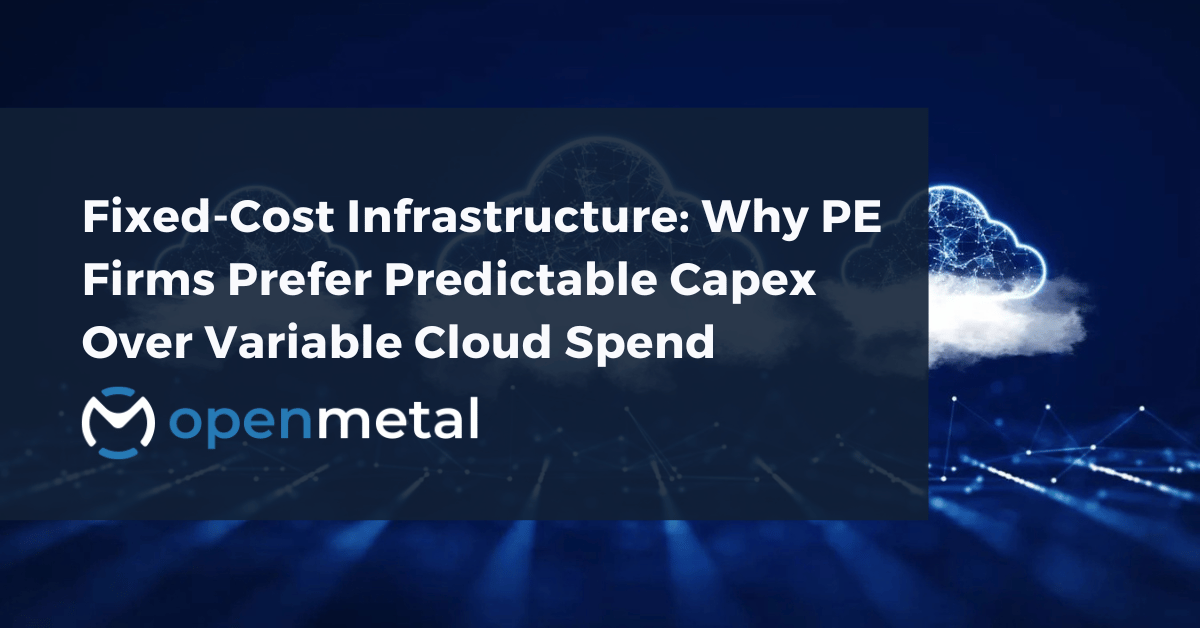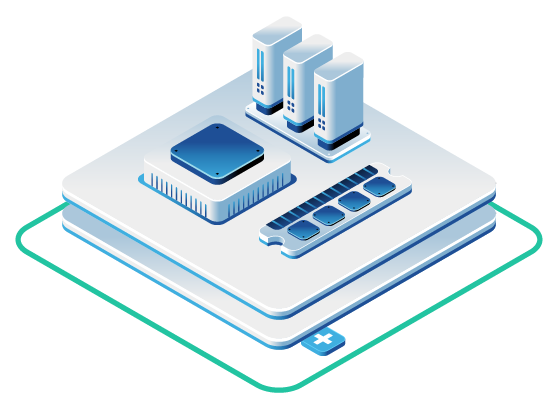
For years, the narrative was simple: move to the cloud, pay for what you use, and watch your business scale effortlessly. But private equity firms managing SaaS portfolios are discovering a more complex reality. When your portfolio company’s infrastructure bill fluctuates by thousands of dollars month to month based on traffic patterns, API calls, and data transfer volumes, accurate EBITDA forecasting becomes nearly impossible. According to the Flexera 2024 State of the Cloud report, 84 percent of organizations cite cost optimization as their top cloud initiative1. Variable cloud costs aren’t just unpredictable—they’re actively undermining the financial performance metrics that matter most to PE investors. The shift toward fixed-cost infrastructure isn’t about nostalgia for data center ownership or resistance to cloud technology. It’s about creating the same cost predictability that PE firms expect from capex investments while maintaining the operational benefits that made cloud attractive in the first place.
The Capex vs. Opex Reality for PE-Backed Companies
Traditional capital expenditure models gave CFOs one thing that variable cloud pricing cannot: predictability. When you purchase physical servers or build out data center capacity, you know exactly what you’ll spend, when you’ll spend it, and how to depreciate those assets over time. Financial modeling becomes straightforward because infrastructure costs behave like other fixed assets on your balance sheet.
Public cloud providers disrupted this model by converting infrastructure from capex to opex. The promise was compelling: eliminate upfront costs, pay only for resources you consume, and scale instantly based on demand. For early-stage startups and companies with highly variable workloads, this model delivers genuine value.
But for established SaaS companies with predictable usage patterns, the math changes. Research from Andreessen Horowitz reveals that $100 billion of market value is being lost among the top 50 public software companies due to cloud impact on margins. The very elasticity that made cloud attractive for startups becomes a liability for mature businesses trying to demonstrate consistent financial performance.
Private equity firms face challenges with lack of visibility and cost allocation, as they often deal with many cloud services, accounts and instances across their portfolio companies. This decentralized environment makes tracking expenses accurately difficult, especially as cloud environments increase in size and complexity.
The financial impact extends beyond monthly bill fluctuations. High-growth software companies often trade at 24-25x gross profit multiples, meaning every dollar of gross profit saved through infrastructure optimization translates to $24-25 in market capitalization gains. For PE firms focused on exit valuations, infrastructure cost structure directly impacts the multiple portfolio companies can command.
Why Variable Cloud Pricing Undermines EBITDA Targets
Understanding the mechanics of how cloud costs erode EBITDA requires examining the specific billing structures that create unpredictability. Unlike software licensing or hardware depreciation, public cloud costs fluctuate based on decisions that engineering teams make daily, often without full visibility into the financial implications.
Usage-Based Pricing Creates Direct Margin Pressure
The fundamental challenge with usage-based billing is that it ties infrastructure costs directly to business growth. When your SaaS company acquires new customers or processes more data, infrastructure costs increase immediately—often faster than the revenue those customers generate. This creates drag on gross margins precisely when companies should benefit from economies of scale.
Public cloud costs can reach 50% of total cost of revenue for software companies, and companies often exceed their committed cloud spend forecast by at least 2X. For PE-backed companies under pressure to demonstrate consistent EBITDA growth, this unpredictability makes financial planning difficult and margin expansion targets harder to achieve.
The problem compounds during seasonal traffic spikes, product launches, or customer onboarding periods. Teams over-provision resources to avoid performance issues, knowing that under-provisioning could impact customer experience. This defensive approach drives up costs without corresponding revenue increases, creating a structural inefficiency in how infrastructure spending relates to business outcomes.
Resource Waste in Shared Environments
The inefficiency of multi-tenant cloud architectures becomes apparent when examining actual resource utilization. In typical public cloud deployments, workloads use roughly 30% of allocated resources on average and burst to use no more than 30% more over time, leaving approximately 40% of VM resources wasted. Yet you still pay for 100% of those allocated resources whether you use them or not.
This waste occurs because public cloud providers design instance types and pricing models that maximize their revenue per server, not your workload efficiency. You’re often forced to choose configurations that don’t align with your actual application requirements, resulting in paying for resources your applications cannot use.
Overprovisioning and underutilization of cloud resources are common issues within portfolio company operations, and the combination of complex and fluctuating cloud workloads coupled with unpredictable resource usage patterns make it challenging to optimize cloud resources effectively. This leads to unnecessary costs and inefficiencies across portfolio companies.
The Hidden Tax of Data Transfer
Data egress fees represent one of the most problematic hidden expenses for growing SaaS companies. These charges are minimal during initial deployment but compound as customer bases grow and data processing increases. The challenge is that egress fees are largely invisible during architecture and budgeting phases.
Development teams focus on compute and storage costs during planning, but data transfer pricing only becomes apparent after deployment when changing architecture becomes expensive and disruptive. For portfolio companies scaling their customer bases, these fees can represent substantial portions of monthly infrastructure bills, creating cost structures that penalize business success.
Instance Type Constraints
Public cloud providers force you to choose from predetermined configurations that rarely align with actual workload requirements. Your applications need specific combinations of CPU, memory, and storage, but you’re constrained to pick from what hyperscalers offer, not what your applications actually need.
This often results in over-provisioned infrastructure to handle peak loads that occur infrequently. You’re paying premium prices for resources you need occasionally while leaving other capabilities underutilized, creating structural inefficiency in infrastructure spending.
How Fixed-Cost Infrastructure Changes the Financial Model
Fixed-cost infrastructure fundamentally changes how portfolio companies budget, forecast, and optimize their technology spending. Rather than treating infrastructure as a variable expense that fluctuates with usage patterns, it becomes a predictable line item that behaves like other capital investments.
Hardware-Based Pricing Eliminates Variables
OpenMetal delivers private infrastructure with a fixed-cost pricing model designed around dedicated hardware capacity rather than usage-based billing. Customers know the cost of their environment in advance, since pricing is determined by the server configurations they deploy, not the number of virtual machines or the volume of API calls.
This approach avoids the metered, variable charges that are common in hyperscale public cloud platforms. Private cloud deployments begin with a minimum three-server Cloud Core, running OpenStack and Ceph, which can be scaled in minutes by adding servers. Because each configuration has a clear monthly cost, scaling decisions can be planned with full cost visibility.
Hardware specifications are transparent, with defined server types such as Medium V4, Large V4, XL V4, and GPU nodes. Each has a known monthly cost that aligns with its compute, memory, and storage resources.
This creates a capex-like structure, where portfolio companies can budget infrastructure spend with the same predictability as physical assets, rather than facing fluctuating opex costs tied to unpredictable usage patterns.
Network and Storage Costs Become Predictable
Networking and storage costs follow the same predictable model. Each server includes dual 10 Gbps NICs and unmetered private networking between servers, meaning that internal traffic does not create hidden fees. Public traffic is handled with included egress allowances that aggregate across servers in a cluster.
Any additional usage is billed at a clear 95th percentile rate, which averages peak traffic rather than penalizing for temporary spikes. This provides more stable and predictable cost management compared to the per-gigabyte charges of public cloud providers that can surprise portfolio companies with unexpectedly high bills during traffic surges.
By combining open source technology foundations with dedicated hardware, OpenMetal eliminates the licensing fees and variable pricing models that drive volatility in cloud bills. This makes it possible for private equity firms to create predictable financial models across their portfolio companies and to improve EBITDA by replacing unpredictable variable cloud costs with transparent infrastructure pricing.
Right-Sizing Without Constraints
Rather than forcing portfolio companies into predetermined instance types, fixed-cost infrastructure allows teams to select hardware configurations that match actual workload requirements. Medium V4 servers use Intel Xeon Silver 4510 processors with 256 GB DDR5 memory, suitable for smaller SaaS platforms or development environments.
Large V4 configurations with Intel Xeon Gold 6526Y processors and 512 GB DDR5 memory handle production workloads for growing SaaS companies. For compute-intensive applications, XL V4 and XXL V4 servers with Intel Xeon Gold 6530 processors provide 1 TB and 2 TB DDR5 memory respectively.
This hardware-based approach typically results in cost savings of 30-50% compared to equivalent public cloud deployments while providing dedicated resources that improve performance predictability. Portfolio companies aren’t paying for more than they need, and they aren’t constrained to less than they can use.
The Operating Partner Advantage: Portfolio-Level Cost Management
For PE operating partners managing multiple SaaS companies, infrastructure consistency creates strategic advantages that extend beyond individual company cost savings. When portfolio companies operate on similar infrastructure platforms with predictable cost structures, operating partners can implement standardized financial reporting, share optimization strategies, and create repeatable playbooks for value creation.
Creating Comparable Financial Metrics
When each portfolio company runs on different cloud providers with unique pricing models, comparing infrastructure efficiency across the portfolio becomes nearly impossible. One company might have high compute costs but low storage expenses, while another faces the opposite. Variable pricing makes it difficult to establish benchmarks or identify outliers that need attention.
Fixed-cost infrastructure creates apples-to-apples comparisons. Operating partners can evaluate infrastructure spending as a percentage of revenue across portfolio companies, identify best practices from high-performing companies, and quickly spot situations where costs are out of line with business metrics.
This standardization becomes valuable during board meetings and investor reporting, where demonstrating consistent financial management across the portfolio matters for fundraising and LP relations.
Implementing Consistent Optimization Strategies
Private equity firms frequently acquire and integrate companies with diverse IT infrastructures, applications, and cloud contracts, which can complicate the management of cloud costs. However, these acquisitions also present opportunities to reduce costs by renegotiating vendor contracts under more favorable terms and consolidating services.
When multiple portfolio companies operate on similar infrastructure platforms, operating partners can share insights about configuration optimization, scaling strategies, and performance tuning. An architecture pattern that reduces costs at one company can be quickly evaluated and potentially applied across other portfolio companies facing similar challenges.
This knowledge transfer accelerates time-to-value for new acquisitions, as operating partners can apply proven strategies rather than starting optimization efforts from scratch at each company.
Accelerating Due Diligence and Integration
For PE firms evaluating new acquisition targets, infrastructure costs and architecture represent important diligence items. Companies approaching diligence phases particularly benefit from infrastructure cost optimization, as improved gross margins and predictable cost structures enhance valuations during the evaluation process.
When your existing portfolio operates on fixed-cost infrastructure, evaluating potential acquisitions becomes more straightforward. You can quickly model what their infrastructure would cost on your preferred platform, identify immediate cost savings opportunities, and include infrastructure optimization in your value creation plan.
Post-acquisition, the integration process moves faster when you have established infrastructure patterns. Rather than managing yet another unique cloud environment, you can migrate the new portfolio company to your standardized platform, immediately capturing cost savings and operational efficiencies.
When Fixed-Cost Infrastructure Delivers Maximum Value
Not every portfolio company benefits equally from fixed-cost infrastructure. The economics depend on workload characteristics, growth stage, and current cloud spending levels. Understanding these factors helps operating partners prioritize which companies should transition first and how to sequence migrations across the portfolio.
Scale Thresholds That Justify Transition
The cost-benefit calculation for fixed-cost infrastructure improves as spending increases. Portfolio companies spending less than $50,000 monthly on cloud infrastructure may not see immediate savings large enough to justify migration effort. The operational overhead of managing infrastructure, even in a hosted private cloud model, requires minimum scale to produce meaningful returns.
Companies spending $100,000 or more monthly on public cloud typically see immediate cost reductions of 30-50% when moving to fixed-cost infrastructure. At this scale, the savings justify migration investment and the ongoing effort of managing dedicated resources.
For portfolio companies approaching $500,000 or more in monthly cloud spending, fixed-cost infrastructure often becomes strategically necessary rather than just financially attractive. At these spending levels, variable costs create significant EBITDA volatility that impacts valuation multiples and investor confidence.
Workload Predictability Matters
SaaS applications with consistent usage patterns benefit most from fixed-cost infrastructure. Companies where traffic, data processing, and resource consumption remain relatively stable month-to-month can accurately size their infrastructure needs and avoid paying for unused capacity.
Businesses with highly seasonal workloads or unpredictable traffic spikes may still benefit from hybrid approaches that combine fixed-cost infrastructure for baseline capacity with public cloud resources for temporary bursts. However, many portfolio companies discover that their workloads are more predictable than they initially assumed once they examine actual usage patterns rather than theoretical capacity needs.
Growth Stage Considerations
Early-stage companies still finding product-market fit and iterating rapidly on architecture often benefit from public cloud’s flexibility. The ability to spin up new services, experiment with different configurations, and pivot architecture without infrastructure commitments supports rapid iteration.
However, once companies reach growth stage with established product architectures and predictable customer acquisition patterns, the economics shift toward fixed-cost infrastructure. The operational flexibility of public cloud becomes less valuable when architecture stabilizes, while the cost predictability of dedicated infrastructure becomes increasingly important for financial planning.
Building Migration Strategies That Minimize Risk
The operational concern that keeps many operating partners from pursuing fixed-cost infrastructure is migration risk. Moving production workloads from public cloud to private infrastructure requires careful planning, but proven methodologies exist that minimize both technical and business risks.
Phased Migration Approach
Rather than attempting to migrate all workloads simultaneously, successful transitions follow a phased approach that validates performance and cost savings at each stage. Development and staging environments move first, allowing teams to build familiarity with the new platform before transitioning customer-facing systems.
This initial phase serves multiple purposes. Engineering teams learn how to deploy, configure, and manage infrastructure on the new platform without production pressure. Architectural patterns get validated in non-critical environments. Cost savings become apparent even before production migration begins, building confidence in the financial model.
Production workloads with predictable resource requirements represent the next logical candidates for migration. Database servers, application servers running stable codebases, and internal services typically migrate smoothly since their performance characteristics are well understood.
High-traffic customer-facing applications move last, after teams have developed confidence operating the platform and optimizing performance. By this stage, most technical unknowns have been resolved, and the migration becomes primarily about execution rather than exploration.
Engineer-Assisted Onboarding
One reason many portfolio companies hesitate to move from public cloud is concern about operational burden. Public cloud providers offer managed services that abstract away infrastructure management, and teams worry about taking on operational responsibility for dedicated resources.
OpenMetal addresses this through engineer-assisted onboarding that helps portfolio companies plan and execute transitions without disrupting customer-facing services. This support covers architecture review, migration planning, and performance optimization to ensure applications operate efficiently in the new environment.
Direct access to OpenMetal engineers provides ongoing support that reduces the operational burden on portfolio company teams. This support model allows SaaS companies to benefit from private cloud economics without requiring significant increases in internal infrastructure expertise.
Ramp Pricing for Cash Flow Management
Financial constraints during migration represent another common concern. Portfolio companies may face situations where they need to maintain both public cloud and private infrastructure during transition periods, creating temporary cost increases before savings materialize.
Ramp pricing allows companies to gradually transition workloads while managing cash flow during the migration period. This approach eliminates the need for large upfront commitments while enabling companies to validate cost savings and performance improvements before full migration.
For PE firms managing multiple portfolio companies through transitions, staggered migrations across the portfolio spread both internal resources and cash requirements over time, making infrastructure optimization a sustainable initiative rather than a disruptive project.
Making Infrastructure a Strategic Advantage
The most sophisticated PE firms are recognizing that infrastructure isn’t just an operational expense to be minimized—it’s a strategic asset that can create competitive advantages when managed thoughtfully. Fixed-cost infrastructure enables pricing strategies, performance characteristics, and financial predictability that become difficult for competitors to match.
Performance Consistency as Product Differentiation
Dedicated infrastructure resources provide performance consistency that can become a product differentiator, particularly for enterprise SaaS offerings where reliability and responsiveness directly impact customer satisfaction and retention rates. When your application runs on dedicated hardware rather than competing for resources in multi-tenant environments, you can offer SLAs and performance guarantees that competitors cannot match.
This performance advantage becomes especially valuable for data-intensive applications, real-time processing systems, and enterprise platforms where milliseconds of latency matter to end users. Portfolio companies can position dedicated infrastructure as a premium feature that justifies higher pricing or longer contract terms.
Cost Structure as Competitive Moat
Predictable infrastructure costs enable more aggressive pricing strategies and higher gross margins, creating competitive advantages that compound over time. SaaS companies with efficient infrastructure can invest more in product development, sales, and marketing while maintaining healthy unit economics.
When competitors face variable cloud costs that scale with customer acquisition, they encounter natural limits on how aggressively they can price products or how much they can invest in customer acquisition. Portfolio companies with fixed-cost infrastructure face different economics—they can grow customer bases without proportional infrastructure cost increases, creating structural advantages in customer acquisition cost and lifetime value calculations.
Financial Predictability for Strategic Planning
Beyond direct cost savings, the predictability of fixed infrastructure costs enables more accurate financial forecasting and reduces the volatility that markets penalize in SaaS valuations. CFOs can model infrastructure as a fixed percentage of revenue rather than a variable that fluctuates with usage patterns.
This predictability becomes valuable during fundraising or exit processes, where consistent margins and clear cost structures affect company valuations. Buyers and investors value SaaS companies with predictable unit economics and clear paths to margin expansion. Infrastructure that behaves like capex rather than variable opex creates financial models that sophisticated investors recognize and reward.
Implementing Fixed-Cost Infrastructure Across Your Portfolio
For operating partners ready to pursue infrastructure optimization as a value creation initiative, success requires systematic assessment, prioritization, and implementation across portfolio companies. The most effective approaches follow proven methodologies that balance speed with risk management.
Candidate Assessment Framework
Start by identifying which portfolio companies stand to benefit most from fixed-cost infrastructure. The best candidates typically share several characteristics: annual cloud spending approaching $1 million or more, predictable workload patterns with consistent resource requirements, and cloud costs representing 50% or more of cost of revenue.
Applications requiring consistent performance characteristics—such as real-time processing or customer-facing APIs with strict SLA requirements—benefit from the dedicated resources and predictable latency that private cloud provides. Data-intensive applications often see the largest cost improvements, as these workloads frequently trigger significant egress charges in public cloud but operate efficiently within private cloud environments.
Building the Financial Model
Accurate ROI calculations should include both direct cost savings and indirect benefits like improved performance and reduced operational complexity. The most comprehensive models account for staff time, support costs, and the value of improved predictability in financial planning.
Experts converge on this formula: Repatriation results in one-third to one-half the cost of running equivalent workloads in the cloud. For portfolio companies with significant cloud commitments, this level of cost reduction flows directly to EBITDA improvement and enhanced exit valuations.
Factor in the timing of cost savings. While some benefits materialize immediately upon migration, others compound over time as companies avoid the usage-based pricing increases that typically accompany business growth in public cloud environments. The financial model should reflect both immediate savings and long-term trajectory improvements.
Creating Implementation Timelines
Sequence migrations across the portfolio based on both potential impact and execution readiness. Companies with simpler architectures, stronger technical teams, and more immediate financial pressure should move first. Their success creates blueprints and builds confidence for subsequent migrations.
Allow sufficient time for each migration phase. Rushing transitions creates unnecessary risk and can undermine team confidence if problems occur. Most successful migrations span three to six months from initial planning to full production cutover, with careful validation at each stage.
Build in time for knowledge transfer across portfolio companies. As early migrations succeed, capture lessons learned and best practices that can accelerate subsequent company transitions. The goal is to make each migration easier than the last by building institutional knowledge across the operating partner team.
The Strategic Imperative: Infrastructure as Financial Engineering
The shift from variable cloud costs to fixed-cost infrastructure represents more than tactical cost reduction for PE portfolio companies. It’s financial engineering that improves both current EBITDA performance and long-term value creation potential.
When infrastructure costs behave predictably, CFOs can forecast more accurately, boards can plan more confidently, and investors can value companies more precisely. The difference between paying for what you use and paying a known amount for what you have changes the fundamental financial character of how SaaS companies operate.
For PE firms managing SaaS portfolios, this shift creates systematic value creation opportunities across multiple companies simultaneously. The compounding effect of improving gross margins, reducing cost volatility, and creating more predictable financial models translates to tens of millions in enhanced valuations at exit.
The question for operating partners isn’t whether fixed-cost infrastructure makes financial sense—the mathematics are clear. The question is how quickly you can assess your portfolio, prioritize candidates, and implement transitions that convert infrastructure from an EBITDA drag into a competitive advantage.
Companies that move early benefit from years of cost savings and improved margins that compound over time. Those that wait face increasingly difficult competitive dynamics as peers optimize their cost structures and can price more aggressively or invest more heavily in product development and customer acquisition.
Taking Action on Infrastructure Optimization
If you’re an operating partner, CFO, or CTO at a PE-backed SaaS company, the path forward begins with an honest assessment of your current infrastructure costs and their impact on financial performance. Review monthly cloud bills not just for total spending, but for variability month-to-month. Examine what percentage of cost of revenue your infrastructure represents. Calculate what a 30-50% reduction in those costs would mean for EBITDA and potential exit valuation.
For portfolio companies spending $100,000 or more monthly on public cloud, the conversation about fixed-cost infrastructure should be happening now. The financial impact is measurable, the implementation risk is manageable, and the competitive advantage compounds over time.
The most successful PE firms are treating infrastructure optimization as a systematic value creation opportunity that delivers measurable EBITDA improvements while positioning portfolio companies for premium exit valuations. By converting variable cloud costs into predictable fixed expenses, SaaS companies improve unit economics, create sustainable competitive advantages, and build financial models that sophisticated investors recognize and reward.
Ready to evaluate how fixed-cost infrastructure can improve financial predictability across your SaaS portfolio? Explore OpenMetal’s PE firm program →
[1] Flexera. “2024 State of the Cloud Report.”
Read More on the OpenMetal Blog



































